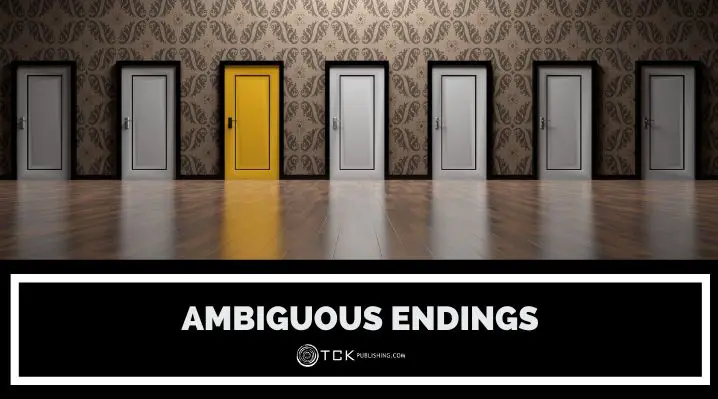
You’ve finished a book or a show, and things end with a question. You’re confused, maybe even annoyed. That’s it?
And days later, you’re still thinking about it. That’s the power of an ambiguous ending.
What Is an Ambiguous Ending?
An ambiguous ending leaves parts of the story unresolved on purpose. Unlike a cliffhanger, which teases a sequel, this ending transfers power to you. They invite you to think, reflect, and decide what you believe happened.
In some stories, events are murky. Did the main character live or die? In others, the events are clear, but their meaning isn’t. Was the villain right all along?
Either way, it’s now up to you.
Are Ambiguous Endings Lazy Writing?
Critics often call open endings a cop-out. They claim writers use it when they can’t find a proper resolution.
That could be true. But you also can’t ignore that some open-ended stories are well-written. Their endings become part of their legacy. Effective ambiguity takes more skill, not less. It all boils down to purpose.
Bad ambiguous endings do happen. They feel random or frustrating because they stop a story, not finish it. All that journey, but it turns out there’s no destination. That feels cheap.
Good ones feel intentional and meaningful. They match the story’s themes and tone. You’re giving your readers a choice. What ending matters to them the most? That makes them engage with your story long after they’ve read it.
Examples of Ambiguous Endings
Here are some examples of stories with ambiguous endings, taken from literature and movies:
Inception
This mind-bending film ends with the main character spinning a top. If it stops spinning, then he’s in reality. If it spins indefinitely, then he’s in a dream.
The audience sees it wobble, but the screen fades to black. Did it fall or keep spinning? It reinforces the film’s central question of what is real and what is not.
Lost in Translation
A has-been (Bill Murray) and a young hopeful (Scarlett Johansson) form a connection that’s between friendship and romance. The movie ends with a bittersweet embrace, a kiss, and Murray whispering something into Johansson’s ear.
What he said is never revealed. That’s the point. Their connection is the story. The rest is up to you.
The Turn Of The Screw by Henry James
A young governess is hired to care for two orphaned children at a remote estate. She soon becomes convinced that the children are haunted by malevolent spirits.
But nothing is ever confirmed. Are the ghosts real? Or is the governess an unreliable narrator, losing her grip on reality?
How To Write An Ambiguous Ending
Here are some tips for writing an effective, ambiguous ending:
Match it to your theme.
If your story explores complex, subjective themes, don’t wrap it up with a tidy bow. Let your audience come to their own conclusion. An ambiguous ending doesn’t cheat them—it invites them to decide what the story means to them.
Build clarity first.
Your story needs a solid foundation before you can play with uncertainty. Create clear characters, settings, and conflicts. Your readers can’t speculate what happens next if they don’t have much to work with.
Plant seeds early.
Don’t drop a twist or mystery at the end out of nowhere. That’s an abrupt change of storytelling and makes the ending feel like a cop-out.
Give hints. Create space for questions to grow. Include details that support different possible interpretations.
For example, The Turn of the Screw never confirms the ghosts are real. Only the governess sees them, which casts doubt on everything she says.
Provide emotional closure.
Your main characters should complete an emotional journey. Show how they change, for better or worse. Even if the final 10% of the story is left unseen, the 90% that’s shown should leave a mark on them.
Readers can handle open plot threads, but they do need some emotional satisfaction.
Consider reader expectations.
Some genres, and their readers, can be more open to having ambiguous endings. For example, detective fiction almost always has the case solved at the end. Literary fiction, however, often welcomes ambiguity.
Be aware of what your audience wants. At the same time, you can be bold. If you plan on breaking rules, do it not to be artsy. Do it because it’s the best for your story. Subvert their expectations and let them fill in the blanks.
Don’t add new questions.
Don’t introduce brand-new info or twist the story last-minute. Ambiguous endings work because their unanswered questions have been marinating in the audience’s minds.
When Is an Ambiguous Ending Justified?
An ambiguous ending isn’t always the right choice. But sometimes, it fits perfectly. Here are some reasons they can be justified:
If they serve the theme.
Stories about uncertainty, free will, or complex moral questions benefit from conclusions that resist simple answers. You want your audience to think and arrive at an answer that satisfies them, rather than spoonfeeding them one.
If it mirrors real life.
Life is rarely neat. Sometimes, ambiguous endings feel honest because they fit what happens in real life.
Some stories also feel fake when you end them neatly, especially if their central question has no easy answer. An ambiguous ending respects their complexity instead of forcing an artificial resolution.
If a character’s emotional arc is done.
An ambiguous ending works when readers feel like the character has changed or grown in a meaningful way. The story might leave you wondering what happens next, but you know who the character has become. That’s satisfying in its own way.
How do you write ambiguous endings? Share your thoughts below!
If you enjoyed this post, then you might also like:
- 6 Types of Endings and How You Can Write Them Effectively
- 20 of the Saddest Endings on Screen and Paper
- Famous Last Lines: 15 of the Best Book Endings in Literature

Cole is a blog writer and aspiring novelist. He has a degree in Communications and is an advocate of media and information literacy and responsible media practices. Aside from his interest in technology, crafts, and food, he’s also your typical science fiction and fantasy junkie, spending most of his free time reading through an ever-growing to-be-read list. It’s either that or procrastinating over actually writing his book. Wish him luck!
